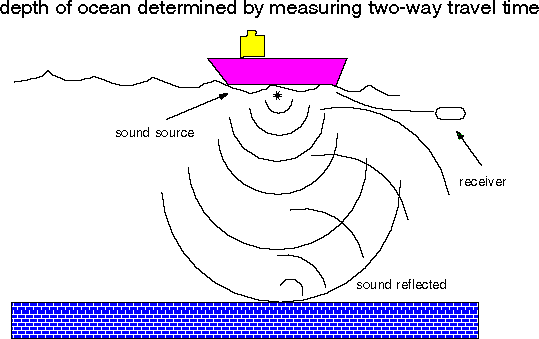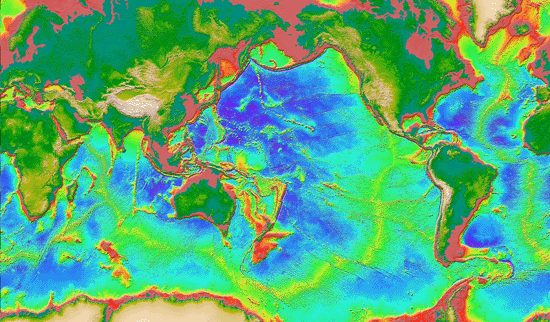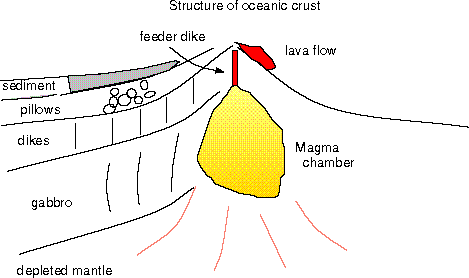
The shape of the ocean basins has been known vaguely since the expedition of the Challenger over 100 years ago. In the 50's the shape was further defined by means of "pingers". The ship emits a sound at a particular frequency as shown here:

The sound reflects off the sea floor and the echo is "heard" by a receiver. The time it takes for the sound to travel down and back (the two-way travel time) can be converted into distance to the sea floor, provided the velocity of sound in water is known (which it is). Data collected in such a way led to the maps that you have seen from National Geographic. The artist, Marie Tharp, and her friend the oceanography, Bruce Heezen, drew the picture from a series of depth measurements obtained on a number of cruises. Nowadays, we can use gravity data measured by satellites to get a much higher resolution picture of the bathymetry (depth) of the ocean:

Taking an imaginary tour through the depths of the Atlantic ocean, we step off the beach in Florida and head for Africa.

The first thing we encounter is the broad, slightly dipping continental shelf. Depending on where we are, this can be several hundred kilometers wide. At the edge of the shelf, the ground begins to steepen, forming the continental slope. The continental rise is somewhat more gradual and is composed of essentially the debris coming off the shelf. The continental margin can be incised by deep canyons. Here are some examples from http://www.ldeo.columbia.edu/us_margins.
 Full Size: 800x650,~230 Kbyte Numerous, deep submarine canyons cut
by subsea avalanches occur off New Jersey, Delaware and Maryland. Click
on image to view at full size.
Full Size: 800x650,~230 Kbyte Numerous, deep submarine canyons cut
by subsea avalanches occur off New Jersey, Delaware and Maryland. Click
on image to view at full size.
 Full Size: 800x650,~270 Kbyte A seascape of plateaus and canyons reach
out from the Californian coast where the North American Plate is sliding
past the Pacific Plate along a complex system of faults, including the
San Andreas Fault. Click on image to view at full size.
Full Size: 800x650,~270 Kbyte A seascape of plateaus and canyons reach
out from the Californian coast where the North American Plate is sliding
past the Pacific Plate along a complex system of faults, including the
San Andreas Fault. Click on image to view at full size.
The continental rise gives way to the abyssal plain that is some 4 to 6 km deep. The plain is punctuated by underwater volcanoes called seamounts. Seamounts often begin life as emergent volcanoes (e.g. The Azores), which depending on their location can be covered with coral reefs (e.g. the Bahamas). As the lithosphere supporting them cools, they submerge. The eroded top makes them "flat-topped" and these seamounts are called guyots. Atolls are volcanic edifices about to become completely submerged, whose coral reefs are desperately trying to keep their heads in the light, forming a living ring of reef, around an already submerged volcano.
In the middle of the Atlantic is the spreading center at which Atlantic crust is formed by the separation of the Americas from Africa and Europe. This long chain of mountains is called the Mid-Atlantic ridge. On the East side of the ridge, the same sequence occurs in mirror image (apart from anomalies like the Azores) and we finally step onto dry land again at Gibraltar.
The Pacific profile is somewhat different from the Atlantic profile. The margin of Australia has no surprises, but the Tonga trench is unlike any feature encountered on our Atlantic tour (although if we had chosen to walk from Puerto Rico instead of from New England, we would have seen something similar - the Puerto Rico Trench). From our lectures on Plate Tectonics, you have probably guessed that the trenches are sites of subduction. Here the oceanic lithosphere is gobbled up by the deeper mantle and begins the grand planetary recycling scheme that distinguishes Earth from her sisters.
Now instead of looking at shape of the ocean basin horizontally, we will go vertically down. Consider the figure:

Ocean crust is formed at spreading centers. There is at least an intermittent magma chamber under the ridge that supplies melt to the surface. The magma travels up to the top through feeder dikes and erupts as lava flows onto the sea floor. Rapid chilling of the magma by the very cold (2 degree C) water results in the water forming looping tube shaped lava flows reminiscent of intestines. These when viewed in profile, look like large "pillows" and such lava flows are often called pillow lavas. The crystallized magma chamber results in a layer of gabbro, the magma sheets chill to form a dike layer and the pillow lavas pile up to form a layer of pillows. With time the crust acquires a blanket of sediment on top, completing the crustal stratigraphy. Underneath this layer of new crust is the depleted mantle, the remaining material after partial melting to supply the magma for the overlying crust.